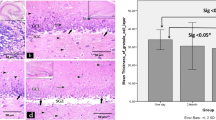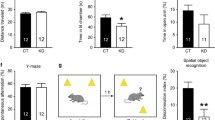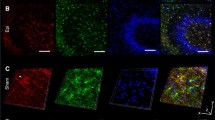Abstract
Similarities between age-related changes in the canine and human brain have resulted in the general acceptance of the canine brain as a model of human brain aging. The hippocampus is essentially required for intact cognitive ability and appears to be particularly vulnerable to the aging process. We observed changes in ionized calcium-binding adapter molecule 1 (Iba-1, a microglial marker) immunoreactivity and protein levels in the hippocampal dentate gyrus and CA1 region of adult (2–3 years) and aged (10–12 years) dogs. We also observed the interferon-γ (IFN-γ), a pro-inflammatory cytokine, protein levels in these groups. In the dentate gyrus and CA1 region of the adult dog, Iba-1 immunoreactive microglia were well distributed and their processes were highly ramified. However, in the aged dog, the processes of Iba-1 immunoreactive microglia were hypertrophied in the dentate gyrus. Moreover, Iba-1 protein level in the dentate gyrus in the aged dog was higher than in the adult dog. IFN-γ expression was increased in the dentate gyrus homogenates of aged dogs than adult dogs. In addition, we found that some neurons were positive to Fluoro-Jade B (a marker for neuronal degeneration) in the dentate polymorphic layer, but not in the hippocampal CA1 region in the aged dog. These results suggest that Iba-1 immunoreactive microglia are hypertrophied in the dentate gyrus in the aged dog.





Similar content being viewed by others
References
Streit WJ, Graeber MB, Kreutzberg GW (1988) Functional plasticity of microglia: a review. Glia 1:301–307
Graeber MB, Streit WJ (1990) Microglia: immune network in the CNS. Brain Pathol 1:2–5
Fu D, Guo Q, Ai Y, Cai H, Yan J, Dai R (2006) Glial activation and segmental upregulation of interleukin-1β (IL-1β) in the rat spinal cord after surgical incision. Neurochem Res 31:333–340
Kreutzberg GW (1996) Microglia: a sensor for pathological events in the CNS. Trends Neurosci 19:312–318
Ambrosini E, Aloisi F (2004) Chemokines and glial cells: a complex network in the central nervous system. Neurochem Res 29:1017–1038
Minghetti L, Visentin S, Patrizio M, Franchini L, Ajmone-Cat MA, Levi G (2004) Multiple actions of the human immunodeficiency virus type-1 Tat protein on microglial cell functions. Neurochem Res 29:965–978
Ling EA, Wong WC (1993) The origin and nature of ramified and amoeboid microglia: a historical review and current concepts. Glia 7:9–18
Lu T, Pan Y, Kao SY et al (2004) Gene regulation and DNA damage in the ageing human brain. Nature 429:883–891
Ma L, Morton AJ, Nicholson LF (2003) Microglia density decreases with age in a mouse model of Huntington’s disease. Glia 43:274–280
Morris RGM, Garrund P, Rawlins JN, O’Keefe J (1982) Place navigation impaired in rats with hippocampal lesions. Nature 297:681–683
Hwang IK, Yoo KY, Kim DW et al (2006) Ionized calcium-binding adapter molecule 1 immunoreactive cells change in the gerbil hippocampal CA1 region after ischemia/reperfusion. Neurochem Res 31:957–965
Fultz M, Barber S, Dieffenbach C, Vogel S (1993) Induction of IFN-γ in macrophages by lipopolysaccharide. Int Immunol 5:1383–1392
De Simone R, Levi G, Aloisi F (1998) Interferon-gamma gene expression in rat central nervous system glial cells. Cytokine 10:418–422
Morrison JH, Hof PR (1997) Life and death of neurons in the aging brain. Science 278:412–419
Hwang IK, Kim DW, Jung JY et al (2005) Age-dependent changes of pyridoxal phosphate synthesizing enzymes immunoreactivities and activities in the gerbil hippocampal CA1 region. Mech Ageing Dev 126:1322–1330
Hwang IK, Yoo KY, Jung BK et al (2006) Correlations between neuronal loss, decrease of memory, and decrease expression of brain-derived neurotrophic factor in the gerbil hippocampus during normal aging. Exp Neurol 201:75–83
Hwang IK, Moon SM, Yoo KY et al (2007) c-Myb immunoreactivity, protein and mRNA levels significantly increase in the aged hippocampus proper in gerbils. Neurochem Res 32:1091–1097
Sultana R, Butterfield DA (2007) Regional expression of key cell cycle proteins in brain from subjects with amnestic mild cognitive impairment. Neurochem Res 32:655–662
Cummings BJ, Head E, Ruehl W, Milgram NW, Cotman CW (1996) The canine as an animal model of human aging and dementia. Neurobiol Aging 17:259–268
Pugliese M, Carrasco JL, Andrade C, Mas E, Mascort J, Mahy N (2005) Severe cognitive impairment correlates with higher cerebrospinal fluid levels of lactate and pyruvate in a canine model of senile dementia. Prog Neuropsychopharmacol Biol Psychiatry 29:603–610
Pugliese M, Carrasco JL, Geloso MC, Mascort J, Michetti F, Mahy N (2004) γ-Aminobutyric acidergic interneuron vulnerability to aging in canine prefrontal cortex. J Neurosci Res 77:913–920
Borràs D, Ferrer I, Pumarola M (1999) Age-related changes in the brain of the dog. Vet Pathol 36:202–211
Shimada A, Kuwamura M, Awakura T, Umemura T, Itakura C (1992) An immunohistochemical and ultrastructural study on age-related astrocytic gliosis in the central nervous systems of dogs. J Vet Med Sci 54:29–36
Ogura K, Ogawa M, Yoshida M (1994) Effects of ageing on microglia in the normal rat brain: immunohistochemical observations. Neuroreport 5:1224–1226
Sheffield LG, Berman NE (1998) Microglial expression of MHC class II increases in normal aging of nonhuman primates. Neurobiol Aging 19:47–55
Candelario-Jalil E, Alvarez D, Merino N, León OS (2003) Delayed treatment with nimesulide reduces measures of oxidative stress following global ischemic brain injury in gerbils. Neurosci Res 47:245–253
Schmued LC, Hopkins KJ (2000) Fluoro-Jade B: a high affinity fluorescent marker for the localization of neuronal degeneration. Brain Res 874:123–130
Lim RKS, Liu CN, Moffitt RL (1960) A stereotaxic atlas of the dogs brain. Charles C Thomas, Springfield
Griffin R, Nally R, Nolan Y, McCartney Y, Linden J, Lynch MA (2006) The age-related attenuation in long-term potentiation is associated with microglial activation. J Neurochem 99:1263–1272
Murray CA, Lynch MA (1998) Evidence that increased hippocampal expression of the cytokine interleukin-1β is a common trigger for age- and stress-induced impairments in long-term potentiation. J Neurosci 18:2974–2981
Maher FO, Nolan Y, Lynch MA (2005) Downregulation of IL-4-induced signalling in hippocampus contributes to deficits in LTP in the aged rat. Neurobiol Aging 26:717–728
Streit WJ, Sammons NW, Kuhns AJ, Sparks DL (2004) Dystrophic microglia in the aging human brain. Glia 45:208–212
Perry VH, Gordon S (1991) Macrophages and the nervous system. Int Rev Cytol 125:203–244
Ward SA, Ransom PA, Booth PL, Thomas WE (1991) Characterization of ramified microglia in tissue culture: pinocytosis and motility. J Neurosci Res 29:13–28
Long JM, Kalehua AN, Muth NJ et al (1998) Stereological analysis of astrocyte and microglia in aging mouse hippocampus. Neurobiol Aging 19:497–503
Nicolle MM, Gonzalez J, Sugaya K et al (2001) Signatures of hippocampal oxidative stress in aged spatial learning-impaired rodents. Neuroscience 107:415–431
Siwak-Tapp CT, Head E, Muggenburg BA, Milgram NW, Cotman CW (2008) Region specific neuron loss in the aged canine hippocampus is reduced by enrichment. Neurobiol Aging 29:39–50
Simic G, Bexheti S, Kelovic Z et al (2005) Hemispheric asymmetry, modular variability and age-related changes in the human entorhinal cortex. Neuroscience 130:911–925
West MJ (1993) Regionally specific loss of neurons in the aging human hippocampus. Neurobiol Aging 14:287–293
West MJ, Kawas CH, Martin LJ, Troncoso JC (2000) The CA1 region of the human hippocampus is a hot spot in Alzheimer’s disease. Ann NY Acad Sci 908:255–259
Rofina J, van Andel I, van Ederen AM, Papaioannou N, Yamaguchi H, Gruys E (2003) Canine counterpart of senile dementia of the Alzheimer type: amyloid plaques near capillaries but lack of spatial relationship with activated microglia and macrophages. Amyloid 10:86–96
Pugliese M, Geloso MC, Carrasco JL, Michetti JMF, Mahy N (2006) Canine cognitive deficit correlates with diffuse plaque maturation and S100β (-) astrocytosis but not with insulin cerebrospinal fluid level. Acta Neuropathol 111:519–528
Wei YP, Kita M, Shinmura K et al (2000) Expression of IFN-γ in cerebrovascular endothelial cells from aged mice. J Interferon Cytokine Res 20:403–409
Mogi M, Kondo T, Mizuno Y, Nagatsu T (2007) p53 protein, interferon-γ, and NF-κB levels are elevated in the parkonsonian brain. Neurosci Lett 414:94–97
Nagatsu T, Sawada M (2005) Inflammatory process in Parkinson’s disease: role for cytokines. Curr Pharm Design 11:999–1016
Acknowledgements
The authors would like to thank Mr. Seok Han, Mr. Seung Uk Lee and Ms. Hyun Sook Kim for their technical help in this study. This work was supported partially by the MRC program of MOST/KOSEF (R13-2005-022-01002-0).
Author information
Authors and Affiliations
Corresponding author
Rights and permissions
About this article
Cite this article
Hwang, I.K., Lee, C.H., Li, H. et al. Comparison of Ionized Calcium-binding Adapter Molecule 1 Immunoreactivity of the Hippocampal Dentate Gyrus and CA1 Region in Adult and Aged Dogs. Neurochem Res 33, 1309–1315 (2008). https://doi.org/10.1007/s11064-007-9584-6
Received:
Accepted:
Published:
Issue Date:
DOI: https://doi.org/10.1007/s11064-007-9584-6




